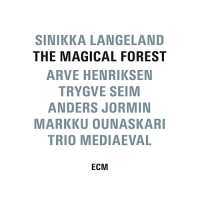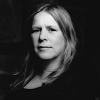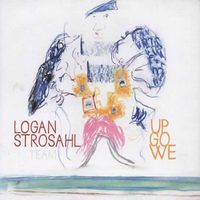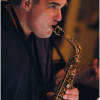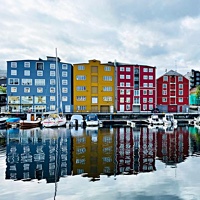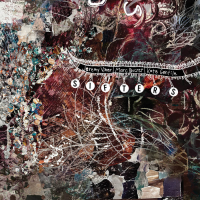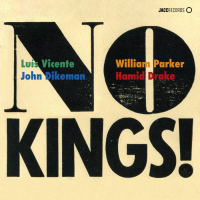Home » Jazz Articles » Album Review » Sinikka Langeland: The Magical Forest
Sinikka Langeland: The Magical Forest
In the ensuing years, Langeland has continued to work with what has become known as her Starflowers group on another superb recording, 2011's The Land That Is Not, performed with a Henriksen-less quartet version of Starflowers at the 2013 Vossa Jazz Festival and, with the release of 2015's The half-finished heaven, introduced a new quartet featuring Starflowers' alumni Seim and Ounaskari, joined by Tomter and Langeland for music with a more decidedly instrumental focus, as well as greater expressive explorations of angular terrain than define the largely melodic Starflowers group's purview.
Despite coming at its music from a different perspective, Trio Mediaeval has, nevertheless, developed a commonality with Langeland that might not have been clear from the Norwegian vocal trio's beginnings around the turn of the millennium. The renowned a cappella group may have carved its initial fame as a vocal-only trio in the classical sphere, interpreting a far-reaching repertoire ranging from early music to 20th/21st century works by the likes of Gavin Bryars, but by the Norwegian vocal trio's fourth album, the appropriately titled Folk Songs (ECM, 2007), it became clear that Trio Mediæval was moving, at least some of the time, into an arena not unlike that of Langeland's, but where the folk tradition this time meets classical music from across the centuries—both artists interested in traditional Norwegian folk music, but from very different (but equally convincing) perspectives.
If that weren't enough to clarify Trio Mediæval's increased reach and gradual synchronicity with Langeland in intent if not approach, then its 2013 Vossa Jazz Festival performance as Trio Mediæval Ensemble most certainly did, with vocalists Anna Maria Friman and Linn Andrea Fuglseth introducing Hardanger Fiddle and portable organ, respectively, to the mix, along with the Melody Chimes that all three singers, including Berit Opheim Versto, had begun using as early as its winter, 2011 Toronto, Canada performance. Fleshed out to a quintet with the addition of Folk Songs' percussionist, Birger Mistereggen, and, in an equally inspired move, Nils Okland—one of Norway's most important, profoundly expressive masters of the Hardanger fiddle, viola d'amore and other violin/viola-like instruments that also include a series of resonating strings below those played with bow or fingers—Trio Mediæval Ensemble's complexion was both a subset of the core trio's reach and, at the same time, a new, overarching approach that significantly expanded its textural palette.
With Langeland and Trio Mediæval Ensemble's 2013 Vossa Jazz shows also positioned back-to- back in the program—and despite major differences in approach, specifically Starflowers' heavy emphasis on improvisation versus TME's more scripted (but still expressly interpretive) performance—the simpatico between the two concerts was hard to ignore. And so, while a further two years went by before Langeland invited both her Starflowers group and Trio Mediæval to Oslo's Rainbow Studio to record The Magical Forest, in retrospect it seems like it was only a matter of time before these two groups came together to create an even richer blend of folk traditionalism, more expansive vocal arrangements and, as always, improvisation.
The truth is, however, a little different than how it might seem. Langeland's desire to blend her Starflowers quintet with Trio Mediæval dates further back: to 2012, in fact, when Sammas- Himmelsøyle—the music of The Magical Forest—was performed, first at the Finnskogutstillingen festival in March 2012 (near where Langeland was born and continues to live) and again, a week later, at the co-commissioning Oslo International Church Music Festival. So, that it took another three years for Langeland to bring the project to the recording studio and another year for it to be released, more than four years after its first performances, only makes the release of this superbly constructed recording all the more welcome.
The beauty of this expanded Starflowers group is the intrinsic chemistry amongst its players: beyond being life partners, Henriksen and Friman have worked together many times, both alone and with Friman's Trio Mediæval mates, like at the trumpeter's beyond-beautiful "Artist in Residence" closing show at the 2009 Molde Jazz Festival, where he was joined, in addition to TM, by keyboardist Ståle Storkken and Jan Bang, for a performance at the town's church that was, not unlike Langeland (but perhaps even more so), both antiquated and thoroughly contemporary. But it's been Henriksen's longtime tenure in Trygve Seim's large ensemble— responsible for both 2000's Different Rivers and 2005's Sangam (both on ECM), as well as festival-defining performances like their 2011 Oslo Jazz Festival set and one-and-only North American appearance in 2007, at Portland, Oregon's PDX Jazz Festival—where the trumpeter and saxophonist have clearly honed a collaborative language that elevates Langeland's music to new heights.
Both Seim and Henriksen value the music and the collective over pyrotechnic demonstrations, though that needn't suggest there isn't plenty of fire and ice, angularity and sheer beauty throughout The Magical Forest. Though their distinctive tones alone demonstrate both players' instrumental mastery, rather than focusing on overt virtuosity, both focus their technical acumen on purity of tone and a means of collective improvisation that's more about two instruments orbiting around each other, only to occasionally find their way into defined unison or harmony lines.
That Jormin shares, with Norwegian bassist Arild Andersen (another ECM stablemate), a particularly rare, singing tone on his double bass doesn't mean there's a lot else to compare the two, beyond muscular tone, lyrical bent and absolute instrumental mastery; it does mean, however, that Jormin is an ideal bassist for Langeland's group: capable of both anchoring the group's rhythm alongside Ounaskari as well as providing a lithe melodic foil for Henriksen, Seim...and Langeland, whose skill on kantele has only grown with each passing year. And while he's honed his own approach over three decades, finding a unique nexus where more propulsive, jazz-centric kit work meets broader percussive textures that blend more appropriately with the more traditionally weighted aspects of Langeland's music, Ounaskari is another ideal player who blends color with an adept ability at maintaining pulse—and in ways not heard quite like this since physical issues forced Jon Christensen to reevaluate how he approaches his kit.
With Starflower now more than a decade old—and Trio Mediæval nearing its 20th anniversary in 2017—the musicians on The Magical Forest have all had the time and opportunity to slowly hone a collective, collaborative vernacular: one defined by the uniqueness of its instrumentation, to be sure; but also one where its egalitarian aesthetic seems to seamlessly afford every musician the opportunity to shine, both as a member of this larger group and as individual players whose distinctive sounds and approaches render each and every one of them instantly recognizable.
Perhaps even more so than Starflowers and The Land That Is Not, The Magical Forest benefits from lessons learned by Langeland on The half-finished heaven, in particular her own instrumental confidence, which allows her to shine on "Puun Loitsu," a brooding album-opener that initially features Langeland's monotone-driven but subtly interpretive delivery of this traditional "Prayer to the Tree Godess," a brief miniature that, at three minutes in length, still manages to unfold as Ounuskari's deeply tribal, malleted toms contrast with Langeland's bowed and plucked kantele, as Trio Mediæval makes its entry with harmonized lines that remain, like Langeland, largely monotone...more chant than song.
As ever, The Magical Forest's sequencing (like so many of ECM's releases) is astute, rendering this 48-minute, nine-song collection of songs and instrumentals a journey unto itself. After the initially dark-hued chant of "Puun Loitsu," the album continues to unfold with Jormin's brief bass intro to "Sammas," a brighter modal piece with hints of the connection between Persian and Northern European folk musics, Trio Mediæval's harmonized legato lines and some exceptional interaction between Jormin's muscular phrases and Ounaskari's delicate cymbals and snare press rolls, before Langeland takes over the vocals, leading into celestial four-part vocal harmony and some empathic lines from Henriksen and Seim, floating over Langeland's delicately plucked kantele, as a repeated vocal chant leads to trumpet and saxophone lines that ultimately come together for a clear conclusion.
While driven by a persistent rhythm, the title track blossoms with greater patience, an instrumental that takes considerable time to reveal itself fully. It's only about two-thirds of the way through, in fact, that Ounaskari and Jormin finally lock in with a persistent pulse which affords Seim and Henriksen the opportunity to build in-tandem, each taking turns at moving slightly to the fore, as one holds down a series of long notes while the other waxes more lyrically, the two finally coming together, again, in a simple unison line that draws the piece to a close.
The Magical Forest represents another step forward for Langeland compositionally, with the singer having written all the music and, for the first time on her ECM recordings, all the lyrics with the exception of "Puun Loitsu," based on a rune song text from Finnskogen. "Karsikko" is a gentler Langeland adaptation of a haunting folk hymn melody from Glåmdalen that features some of Henriksen's most beautiful playing of the set, as well as one of Langeland's most impressive moments, singing alone, self-accompanied on kantele.
While Trio Mediæval plays a more egalitarian role on the album, there are a couple of pieces that more vividly feature the trio's extraordinary and identifiable sound. On the round-driven "Jacob's Dream," Langeland arranges the vocals to emphasize Trio Mediæval's particular strength at effortlessly handing lines from one singer to the next while assuming harmony roles when not at the fore; while "Kamui" is one of Langeland's most compelling songs of the set, her tarter tone positioned all the more impressively for the lush harmony vocals that surround it; but it's only one part of an episodic piece that ultimately leans into more abstract territory before reiterating its lovely chorus, with Henriksen and Seim each adding distinctly separated fills as the song unwinds to its gentle ending.
With the ideal pairing of Trio Mediæval and her Starflowers group, it's hard for The Magical Forest to be anything but a career highlight for Langeland, an artist whose evolution is only partly on show to those solely familiar with her ECM output. Earlier albums on Norwegian labels provide even more insight into how this folk traditionalist evolved into a more forward-looking improviser and writer of music that feels part of an arcane world that's at once of and outside of time. Feeling connected to something centuries old while, at the same time, possessed of unmistakable modernity, The Magical Forest leverages both Langeland and Trio Mediæval's differing but somehow connected angles of approaching traditional folk music, while building on the growing improvisational strength of her Starflowers group to create what is, hands down, the most impressive album of Langeland's career.
Track Listing
Puun Loitsu; Sammas; Jacob's Dream; The Wolfman; The Magical Forest; Koyri; Kamui; Karsikko; Pillar to Heaven.
Personnel
Sinikka Langeland
vocalsSinikka Langeland: kantele, vocals; Trygve Seim: soprano and tenor saxophones; Arve Henriksen: trumpet; Anders Jormin: double bass; Markku Ounaskari: drums, percussion; Trio Mediaeval (Anna Maria Friman, Berit Opheim; Linn Andrea Fuglseth): vocals.
Album information
Title: The Magical Forest | Year Released: 2016 | Record Label: ECM Records
Tags
PREVIOUS / NEXT
Support All About Jazz
 All About Jazz has been a pillar of jazz since 1995, championing it as an art form and, more importantly, supporting the musicians who make it. Our enduring commitment has made "AAJ" one of the most culturally important websites of its kind, read by hundreds of thousands of fans, musicians and industry figures every month.
All About Jazz has been a pillar of jazz since 1995, championing it as an art form and, more importantly, supporting the musicians who make it. Our enduring commitment has made "AAJ" one of the most culturally important websites of its kind, read by hundreds of thousands of fans, musicians and industry figures every month.


